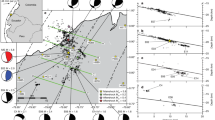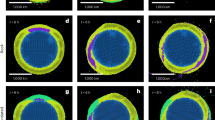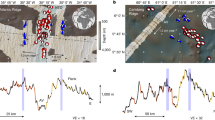Abstract
Recent seismological discoveries have indicated that the Earth's core–mantle boundary is far more complex than a simple boundary between the molten outer core and the silicate mantle. Instead, its structural complexities probably rival those of the Earth's crust1. Some regions of the lowermost mantle have been observed to have seismic wave speed reductions of at least 10 per cent2,3,4,5,6,7, which appear not to be global in extent7,8,9. Here we present robust evidence for an 8.5-km-thick and ∼50-km-wide pocket of dense, partially molten material at the core–mantle boundary east of Australia. Array analyses of an anomalous precursor to the reflected seismic wave ScP reveal compressional and shear-wave velocity reductions of 8 and 25 per cent, respectively, and a 10 per cent increase in density of the partially molten aggregate. Seismological data are incompatible with a basal layer composed of pure melt, and thus require a mechanism to prevent downward percolation of dense melt within the layer. This may be possible by trapping of melt by cumulus crystal growth following melt drainage from an anomalously hot overlying region of the lowermost mantle. This magmatic evolution and the resulting cumulate structure seem to be associated with overlying thermal instabilities, and thus may mark a root zone of an upwelling plume.
This is a preview of subscription content, access via your institution
Access options
Subscribe to this journal
Receive 51 print issues and online access
$199.00 per year
only $3.90 per issue
Buy this article
- Purchase on Springer Link
- Instant access to full article PDF
Prices may be subject to local taxes which are calculated during checkout




Similar content being viewed by others
References
Garnero, E. J. Heterogeneity of the lowermost mantle. Annu. Rev. Earth Planet. Sci. 28, 509–537 (2000)
Mori, J. & Helmberger, D. V. Localized boundary layer below the mid-Pacific velocity anomaly from a PcP precursor. J. Geophys. Res. 100, 20359–20365 (1995)
Garnero, E. J. & Helmberger, D. V. Further structural constraints and uncertainties of a thin laterally varying ultralow-velocity layer at the base of the mantle. J. Geophys. Res. 103, 12495–12509 (1998)
Reasoner, C. & Revenaugh, J. ScP constraints on ultralow-velocity zone density and gradient thickness beneath the Pacific. J. Geophys. Res. 105, 28173–28182 (2000)
Rost, S. & Revenaugh, J. Small-scale ultralow-velocity zone structure imaged by ScP. J. Geophys. Res. 108(B1), 2056, doi:10.1029/2001JB001627 (2003)
Rondenay, S. & Fischer, K. M. Constraints on localized core-mantle boundary structure from multichannel, broadband SKS coda analysis. J. Geophys. Res. 108(B11), 2537, doi:10.1029/2003JB002518 (2003)
Thorne, M. & Garnero, E. J. Inferences on ultralow-velocity zone structure from a global analysis of SPdKS waves. J. Geophys. Res. 109, B08301, doi:10.1029/2004JB003010 (2004)
Castle, J. C. & Van der Hilst, R. D. The core-mantle boundary under the Gulf of Alaska: No ULVZ for shear waves. Earth Planet. Sci. Lett. 176, 311–321 (2000)
Persh, S. E. & Vidale, J. E. Reflection properties of the core-mantle boundary from global stacks of PcP and ScP. J. Geophys. Res. 109, B04309, doi:10.1029/2003JB002768 (2004)
Williams, Q. & Garnero, E. J. Seismic evidence for partial melt at the base of Earth's mantle. Science 273, 1528–1530 (1996)
Vidale, J. E. & Hedlin, M. A. H. Evidence for partial melt at the core-mantle boundary north of Tonga from the strong scattering of seismic waves. Nature 391, 682–685 (1998)
Knittle, E. & Jeanloz, R. Earth's core-mantle boundary; results of experiments at high pressures and temperatures. Science 251, 1438–1443 (1991)
Song, X. & Ahrens, T. J. Pressure-temperature range of reactions between liquid iron in the outer core and mantle silicates. Geophys. Res. Lett. 21, 153–156 (1994)
Berryman, J. G. Seismic velocity decrement ratios for regions of partial melt in the lower mantle. Geophys. Res. Lett. 27, 421–424 (2000)
Murakami, M., Hirose, K., Kawamura, K., Sata, N. & Ohishi, Y. Post-perovskite phase transition in MgSiO3 . Science 304, 855–858 (2004)
Karason, H. & van der Hilst, R. D. Tomographic imaging of the lowermost mantle with differential times of refracted and diffracted core phases (PKP, Pdiff). J. Geophys. Res. 106, 6569–6587 (2001)
Grand, S. P. Mantle shear-wave tomography and the fate of subducted slabs. Phil. Trans. R. Soc. Lond. A 360, 2475–2491 (2002)
Rost, S. & Revenaugh, J. Seismic detection of rigid zones at the top of the core. Science 294, 1911–1914 (2001)
Garnero, E. J. & Vidale, J. E. ScP; a probe of ultralow velocity zones at the base of the mantle. Geophys. Res. Lett. 26, 377–380 (1999)
Cerveny, V. & Psencik, I. Gaussian beams in elastic 2-D laterally varying layered structures. Geophys. J. Int. 78, 65–91 (1984)
Garnero, E. J., Revenaugh, J., Williams, Q., Lay, T. & Kellogg, L. H. in The Core-Mantle Boundary Region (eds Gurnis, M., Wysession, M., Knittle, E. & Buffett, B.) 319–334 (Geodynamics series, Vol. 28, American Geophysical Union, Washington DC, 1998)
Dobson, D. P. & Brodholt, J. P. Subducted iron formations as a source of ultra-low-velocity zones at the core-mantle boundary. Nature 434, 371–374 (2005)
McKenzie, D. P. The extraction of magma from the crust and mantle. Earth Planet. Sci. Lett. 74, 81–91 (1985)
Roscoe, R. The viscosity of suspensions of rigid spheres. J. Appl. Phys. 3, 267–269 (1952)
Akins, J. A., Luo, S.-N., Asimow, P. D. & Ahrens, T. J. Shock-induced melting of MgSiO3 perovskite and implications for melts in Earth's lowermost mantle. Geophys. Res. Lett. 31(14), doi:10.1029/2004GL020237 (2004)
Knittle, E. in The Core-Mantle Boundary Region (eds Gurnis, M., Wysession, M., Knittle, E. & Buffett, B.) 119–130 (Geodynamics Series, Vol. 28, American Geophysical Union, Washington DC, 1998)
Williams, Q., Revenaugh, J. & Garnero, E. J. A correlation between ultra-low basal velocities in the mantle and hot spots. Science 281, 546–549 (1998)
Walker, D., Agee, C. & Zhang, Y. Fusion curve slope and crystal/liquid buoyancy. J. Geophys. Res. 93, 313–323 (1988)
Montelli, R. et al. Finite-frequency tomography reveals a variety of plumes in the mantle. Science 303, 338–343 (2004)
Steinberger, B. Plumes in a convecting mantle: Models and observations for individual hotspots. J. Geophys. Res. 105, 11127–11152 (2000)
Jellinek, A. M. & Manga, M. The influence of a chemical boundary layer on the fixity, spacing and lifetime of mantle plumes. Nature 418, 760–763 (2002)
Acknowledgements
We thank R. van der Hilst and S. Grand for supplying tomographic models, S. Grand for a Futterman t* code, and the Seismological group of MoD at Blacknest for the WRA data set. This research was supported by NSF.
Author information
Authors and Affiliations
Corresponding author
Ethics declarations
Competing interests
Reprints and permissions information is available at npg.nature.com/reprintsandpermissions. The authors declare no competing financial interests.
Supplementary information
Supplementary Materials
Additional tests and methods, and legends for the two Supplementary Figures. This file also contains Supplementary Table S1, which details earthquake location and origin time information for events showing ScP precursory energy (DOC 54 kb)
Supplementary Figure S1
Map view of the best fit t* values. The best-fit t* operators where found by convolving The P-wavelet with the t* operator in the frequency domain and comparing the resultant waveform to the ScP wavelet. (PDF 210 kb)
Supplementary Figure S2a and b.
Subfigures a and b of Supplementary Figure S2 a) Synthetic waveforms for varying density change (p) and fixed P-wave velocity change: α(-10%), S-wave velocity change: β(-10%) and ULVZ thickness: D (8.5km). b) Synthetic waveforms for varying density and fixed α(-10%), β(-25%) and D (8.5km). (PDF 300 kb)
Supplementary Figure S2c
Part c of Supplementary Figure S2 c) Synthetic waveforms for varying βand fixed α(-10%), p(+10%) and D (8.5km). (PDF 242 kb)
Supplementary Figure S2d and e
Contains: Parts d and e of Supplementary Figure S2 c) Synthetic waveforms for varying α and fixed p(0%), β(-25%) and D (8.5km). d) Synthetic waveforms for varying α and fixed p(+10%), β(-25%) and D (8.5km). (PDF 254 kb)
Supplementary Figure S2f and g.
Parts f and g of Supplementary Figure S2 f) Synthetic waveforms for fixed α:β= 1:1 (absolute values vary) and fixed p(+10%), and D (8.5km). g) Synthetic waveforms for fixed α:β= 1:3 (absolute values vary) and fixed p(+10%), and D (8.5km). (PDF 221 kb)
Supplementary Figure S2h and i
Parts h and i of Supplemental Figure 2 h) Synthetic waveforms for varying thickness and fixed α(-10%), β(-25%) and p(0%) i) Synthetic waveforms for varying thickness and fixed α(-10%), β(-25%) and p(+10%). (PDF 257 kb)
Rights and permissions
About this article
Cite this article
Rost, S., Garnero, E., Williams, Q. et al. Seismological constraints on a possible plume root at the core–mantle boundary. Nature 435, 666–669 (2005). https://doi.org/10.1038/nature03620
Received:
Accepted:
Issue Date:
DOI: https://doi.org/10.1038/nature03620
This article is cited by
-
Detections of ultralow velocity zones in high-velocity lowermost mantle linked to subducted slabs
Nature Geoscience (2024)
-
Melting and defect transitions in FeO up to pressures of Earth’s core-mantle boundary
Nature Communications (2023)
-
Internal structure of ultralow-velocity zones consistent with origin from a basal magma ocean
Nature Geoscience (2022)
-
Insights into magma ocean dynamics from the transport properties of basaltic melt
Nature Communications (2022)
-
Mantle plumes and their role in Earth processes
Nature Reviews Earth & Environment (2021)
Comments
By submitting a comment you agree to abide by our Terms and Community Guidelines. If you find something abusive or that does not comply with our terms or guidelines please flag it as inappropriate.



